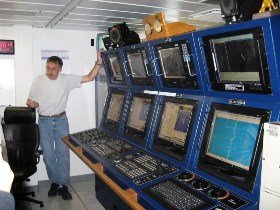
Sitting Still
You might think that steering the ship places would present more of a challenge than sitting still on a drilling station. It turns out both have their unique challenges.
When the ship is “on station” at a drilling location, the Captain and mates rely on a system called Dynamic Positioning to keep the ship located precisely over the hole being drilled. This is harder than it sounds – the drill string might be meters and meters of metal pipe, but when you are talking about long sections going down through the ocean, they don’t stay perfectly straight. They will actually flex and curve somewhat.
So – if the pipe flexes why do we need to stay in position? Several reasons actually. First, is that if the pipe is “tilted” too much, it stresses teh metal and the pipe can fail. Next is that if we get too far from perpendicular over the hole, the drilling can actually end up going at a slight angle, which means we might not drill into the correct layers of rock. Going in at the wrong angle also increases the chances of getting “stuck” in the hole, or damaging equipment.
Luckily, with the DPS (Dynamic Positioning System) it’s all under control! Here’s a picture of our Operations Supervisor Steve Midgley explaining the system during our ship tour.

The system is located in a room just off the Bridge – it’s monitored 24 hours a day, and provides the Captain and mates lots of information and data that they can use to evaluate past conditions and prepare for things like upcoming weather fronts.
Below you can see Second Mate, Steve Bradley monitoring the system while Captain Alex explained to me how it works.
This system takes some simple ideas, such as how fast sound travels through water, and uses them keep the ship positioned correctly over the drill hole. Basically if you can measure how fast a sound arrives at two different locations, you can locate where the sound comes from. The more locations you have receiving the sound and measuring arrival time, the more accurately you can pin point the origin. In the JR’s case, the sound comes from a beacon we drop to the sea floor upon arrival at our site. This beacon sends out a pinging sound at regular intervals. Underneath the ship are five hydrophones (basically “water ears”) that hear the sound. The sound arrives at each hydrophone at a slightly different time (fractions of a second sometimes) and this time difference is fed into a computer and used to calculate the exact position of the beacon relative to the ship. They can keep the ship positioned within a meter or two of the same location using this method. What is incredible about the JR is that she has used this system since the 1970’s – way before GPS technology, and it was just as accurate then. Now days, the DPS is assisted by two GPS locators. There are also 3 wind sensors that feed wind direction into the DPS so that it can adjust for the wind and take it into account when deciding when and how we need to use the ship’s thrusters.
Below you can see one of the data screens on the DPS – it shows the location of the ship and the location of the hole. The beacon is seen as the yellow X.
So, I bet you are surpised to know that so many calculations are involved in sitting still!

